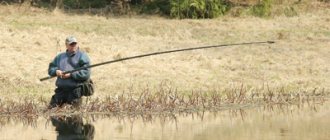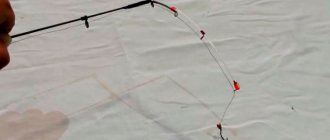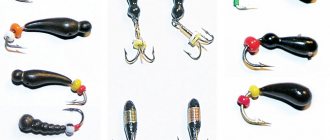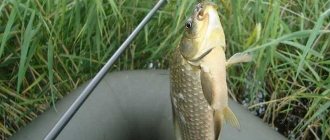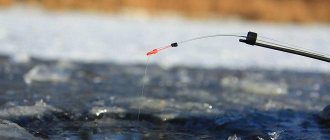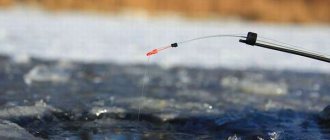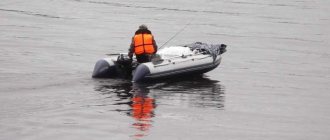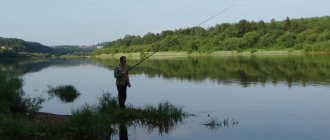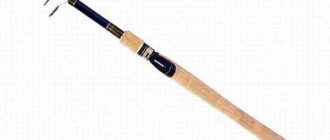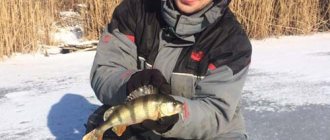What is a nod for?
It is attached to the very end of the winter fishing rod, and is designed, first of all, to report bites . In winter, the fish are inactive and usually do not bite as sharply as in open water in summer. Therefore, the fishing nod must be very sensitive and respond to the slightest touch on the hook with a nozzle, if we are talking about fishing with bait, most often with bloodworms or maggots.
But in winter fishing there is another type of fishing - reelless , when there is no bait as such, and the fish is caught with a jig, spoon or balancer. In this case, the fisherman uses a fishing rod like a spinning rod with a spoon, that is, he makes the jig play and attract fish. True, the actions required here are not as active as when fishing with a spinning rod in the summer; playing with a jig consists of lifting it and lowering it to the bottom with light movements so that the fish becomes interested in it. Here the nod should not only be sensitive, but also resilient and elastic, so that the movements of the jig in the water are as natural as possible.
Nods for winter lure fishing
It is, of course, possible to engage in winter vertical trolling without a nod, and, probably, in those reservoirs where fish stocks are still quite large - this will have little effect on catches. For example, on Ladoga, local fishermen hunt for large perch with large spoons and homemade nodless fishing rods with long (up to 40–50 cm) elastic carbon fiber whips. Due to their length and elasticity, they convey the bite of large perch well and do not require an additional nod. But in the water bodies of the middle zone frequently visited by fishermen, today you cannot do without a nod.
It allows you not only to see a weak bite from a wary fish, but also makes it possible to diversify the game more, making it beautiful and attractive. This primarily applies to light-class spinners weighing up to 7 g.
The sluggish perch does not even seem to touch, but “sniffs” the spoon, and only a varied game with the help of a nod forces it to become more active and grab the bait. As with all other fishing equipment, different nods are used for different fishing conditions.
Nipple rubber nods
They transmit the bite well and allow you to manipulate the bait. The standard nod is 60–70 mm long. A fishing line is passed through it, and the nipple itself is arbitrarily attached to the pole of the fishing rod.
It is with the nipple that the lure can be played best on the ground. This is done as follows...
After measuring the depth and adjusting the tackle, the spoon is placed on the ground. With a slight movement of the hand, the body of the spoon comes off the bottom, while the hook remains lying on the ground. This can only be monitored with the help of a nod (if the spoon comes off the bottom and completely hangs in the water, it will bend more). This work is jewelry and requires fixing the hand on the leg or with the help of another hand.
Cycle: swing, spoon on the ground, second pause, body raised, 3-4 second pause, swing.
With a methodical and uniform game, even a low-active perch cannot stand it and grabs the bait. He either takes it from the bottom, and often when the bait is released, bottom sediments fall out of the perch’s mouth, or he leans on it with his body. In this case, the fish turns purple under the lower jaw or front fins.
When playing in the water column, the nipple nod allows you to “finish” the game of the bait. Firstly, it cushions when the spinner is at its lowest point, when the line is fully stretched and creates a rebound effect. It was as if the fry saw a predator and shied away from it.
Secondly, the elastic nipple nod allows you to make very small jerks (the spoon practically remains in place and moves only to the distance of the length of the nod). This greatly contributes to activating the biting of sluggish perch.
Thirdly, the nipple allows you to complement and diversify the classic game. You can, for example, after a pause, only slightly move the bait on the ground or turn it in different directions (twist). In strong winds, the nipple nods tremble - sometimes this is useful, but more often it is harmful.
Clock spring nods
In addition to all of the above, “metal” nods have one undeniable advantage - they can work not only with light, but also with heavier spoons and balancers. The rigid plate can be adjusted so that the 12-15 gram bait will perfectly nod and show the smallest touches of the fish.
If we equip fishing rods with light class lures with metal nods, then in this case we will get an interesting result. If you put a metal plate up to 0.08 mm thick on the fishing rod, working the bait from the lowest position back, and refining it while playing with such nods will be very different from playing with a nipple. Depending on the stiffness of the spring, it becomes either softer or sharper.
The amplitude of movements and the entire behavior of the spinner as a whole changes. Sometimes this is what saves you from failure. These nods, in my opinion, behave better in strong winds, but to do this you have to find an angle to the wind under which you will sit.
Today, ready-made watch spring nods are sold in all fishing stores, and there is no point in describing them.
Mylar nods
They are made from printing film for printing. Glue two plates together and cut out a nod of the required length and width, and attach it to the fishing rod in any way.
I have repeatedly seen lavsan nods on the fishing rods of amateur fishermen and athletes, but they did not take root with me. The main negative factor was their fragility. During severe frosts, lavsan becomes more brittle, and I did not notice any particular difference in the game in comparison with metal and nipple nods. If the rest of the gear can simply be folded and “thrown” into a box, a fishing rod with a lavsan nod has to be carefully packed in a case - God forbid it gets wrinkled!
Today, these nods are most used during winter trolling, although you can find anglers with both wire and spring nods. These models did not receive proper distribution.
My own game
What other “liberties” does the nodding game allow us?
In addition to the above methods, you can use:
- a slight sway of the nod from side to side, while the spinner begins to “bow”;
- small-fine (like a trembling) tapping of the bait on the bottom. One gets the feeling of a fry actively feeding and forgetting about caution;
- end the swing of the fishing rod with a blow to the palm of the second hand and, after a short pause, slightly move the nod with your finger;
- alternate long swings with short shakes. This method often helps me out when I have no bite;
- allows you to see how, when playing, during a long pause, an interested fish begins to literally “run into” the bait. Pressing on her from above. At the same time, the nod begins to slowly slope down.
In fact, there are a lot of ways to play with a nod. You need to experiment and find your own game. Having several fishing rods with different baits and nods in stock, you can almost always find the “magic key” to the perch’s appetite and leave the reservoir without a scratch.
Fishing rod with and without nod
A winter reelless fishing rod can be equipped without a nod. Then the fishing line with the jig is attached directly to a special whip, which comes from the reel, which the fisherman holds in his hand. This kind of fishing is considered more sporting because it requires the fisher to constantly move the jig and instantly react to a bite. The fact is that when grabbing a jig, the fish immediately feels the metal and in most cases will try to spit out the jig. If you don’t have time to hook him, he will leave.
The big advantage of the nodless moth is its insensitivity to wind .
But a reelless jig with a nod, if you choose it correctly, makes the game more subtle, because the nod allows the jig to play in a special way with its oscillations. When fishing with a nod, the hand gets less tired.
It is probably unnecessary to say in detail that fishing with bait, and even with several fishing rods, without a nod is an almost useless activity, you simply will not notice the bite.
When is a nod used?
A winter fishing rod can be equipped with a float or a nod. In the first case, the fishing rod is equipped with a reel and fishing line with a float that warns of a bite. This type of equipment is often used when fishing with a baited hook. In winter, in frosty weather, the hole quickly becomes covered with ice, and it becomes difficult to monitor the float.
In this case, fishermen use a nod. Sometimes nods for winter fishing rods are used without bait. Its advantage is that it is located above the water, so it does not freeze up and reacts well to bites, allowing you to play slowly and dynamically with the bait.
Requirements
There are many materials from which nods are made; their selection in the store is quite large, but many fishermen prefer to make this tackle with their own hands. In this case, any gatehouse must meet certain requirements:
- it should be sensitive, but at the same time, if possible, not react to the current and wind;
- must be durable; any tackle requires adjustment, if you have to frequently change a broken nod, adjustment will take extra time;
- it must be indifferent to frost and not freeze when exposed to water;
- the weight of the nod and its hardness must be carefully selected;
- finally, it should be easy to replace if necessary.
Kinds
An uninitiated person cannot even imagine how many variants of this gear have already been invented and used. There are also completely unusual ones (for example, Shcherbakov’s nod), looking at which you won’t immediately understand their purpose. But there are also relatively simple, traditional ones. So they are selected depending on the fishing conditions and the availability of material.
By hardness
There are few principles here, but they must be followed:
- a nod that is too hard may not give a signal of a bite if the fish is careful, but when fishing with a jig, it is not suitable at all: with a hard jig, the jig will move sharply and unnaturally in the water, which will only scare off the fish;
- a soft nod is useless in strong winds and can simply bend when playing with a jig so much that the fish’s approach will also go unnoticed.
Soft nods are usually used when fishing in still water, hard ones - in currents and great depths. Medium ones are also used when the current is small.
According to the material of manufacture
There are several popular and accessible materials:
- lavsan ; due to its high sensitivity, it has become an extremely popular material for gatehouses today and has replaced boar bristles, which, for obvious reasons, not everyone can get;
- metal ; is also a very common material for making this gear; fishermen love to use stainless steel; responds well to bites, is resistant to wind and low temperatures, but, unfortunately, is easily deformed; often used to make nod springs;
- silicone ; good and inexpensive material, but short-lived; after several fishing trips it may simply harden and lose elasticity;
- rubber ; it is also sensitive, and nods from it do not have a high price, but in the cold the rubber is prone to cracking;
- carbon fiber ; modern, durable, sensitive, but relatively expensive material;
- boar bristles ; the good old and reliable nod, which was used by our grandfathers, but it also has disadvantages: relative fragility and great sensitivity to side winds.
There are also combined options, when this tackle is made from two materials sequentially.
By lenght
The classic length of the nod is considered to be from 3 to 12 cm. The selection depends on the purpose and method of fishing:
- short guards provide better jig play , but do not provide a large amplitude, which is not suitable for catching large white fish;
- long ones provide good amplitude , but are more susceptible to breakdowns, suffer from the wind, and it is more difficult to ensure play with a jig, as well as monitor the bite when baiting.
Most fishermen have at least two guards in their arsenal - a long and a short one - and try them alternately at the fishing spot.
By elasticity
There are also requirements here:
- when fishing with a jig with a nozzle, the nod should bend at an angle of no more than 45°;
- for a rewinder - 30°.
When fishing with the so-called devil (bait with a tee), elastic nods, initially bent upward, are sometimes used. When a perch bites (it is he who uses this tackle), the guard should drop horizontally, but not lower.
Special designs
Crossbow
This is a winter fishing rod with a nod on a rubber shock absorber . It is used when fishing from the bottom; it is good to catch bream with such a nod. Has undoubted advantages:
- can be used safely in both cold and strong winds;
- displays the most careful bites;
- the mechanism can be adjusted to any bait;
- the fish, sucking the bait from the bottom, does not feel its weight, but, sensing the foreign body of the hook, it removes it, like all the garbage, through the gills and gets hooked.
The disadvantages of the gear include its weak activity. With sudden or fast movements of the fisherman, the nod rises up and interferes with the process.
Mechanical
The design is characterized by the fact that a metal elastic plate or spring with a sinker is attached to the whip of an ordinary winter fishing rod using a special device, which, when slightly shaken, can provide a nod with the fishing line (and, therefore, the jig) of oscillations of different amplitudes. They can be adjusted by moving special guards. Such mechanized nods make fishing easier physically , but not everyone likes it due to the relative passivity of the fisherman.
Shcherbakov's nods
A very original design, in which the nod is attached across the fishing rod on a miniature bearing (!) and is equipped with a sinker on one side. In normal condition, the end of the nod with the fishing line is raised up, and the end with the sinker remains on the ice.
When biting, the end with the fishing line smoothly lowers, and the opposite end, on the contrary, rises, signaling a bite. The gear is highly sensitive, but it is useless for reelless fishing.
But you can install several fishing rods with such nods at once and monitor the condition of the gear from a distance.
Electronic
Electronic nods are equipped with the same nods of Shcherbakov, only instead of a sinker they use light or sound devices with batteries. When they rise up when biting, it is easy to see or hear the corresponding signal.
Types of gatehouses, material of manufacture
The correct choice of a nod for a winter fishing rod guarantees the bait of prey and gives the fisherman a timely signal of a bite. The guard is selected depending on the weight of the bait - the deflection angle should not exceed thirty degrees.
Currently, there are several types of bite alarms that help improve the quality of fishing. Thanks to such gear, pulling prey out of a narrow ice hole is much more convenient and faster. The most popular materials for making gatehouses: metal, plastic, silicone, rubber.
Metal
The most popular metal is stainless steel. The standard nod is 15 centimeters long, quickly sinks into the water and smoothly responds to the movement of water without scaring away the fish. As soon as the prey clings to the bait, the guard reports a bite. Metal nods are worth recommending to novice fishermen who have not gotten used to operating the gear.
Healthy! A stainless steel gatehouse withstands harsh weather and is not afraid of winds and frost. But it has a drawback - a kink appears at the point of attachment to the rod, and the nod becomes unusable.
Plastic (lavsan)
Lavsan has become an excellent replacement for boar bristles, which was previously considered the most popular.
The plastic nod is distinguished by its elasticity, strength and high quality compared to other materials. Such gatehouses are inexpensive, but do not wear out and last a long time.
With a length of 6-8 centimeters, the nod ensures the play of bait for fish and helps to hook prey in time. But there is also a minus - the lavsan guard is lightweight, so it is susceptible to side winds.
Silicone
Silicone guards are in demand among beginners in winter fishing, who buy them for the low price and bright color of the product. But experienced fishermen point out several significant disadvantages:
- rapid wear;
- instability to cold;
- loss of elasticity.
Negative qualities of the guard worsen the performance of the entire tackle and interfere with active fishing. In winter fishing conditions, it is better to give preference to more sustainable materials.
Rubber
Rubber elements for winter gear are used only in warm weather. When the temperature changes, the nod breaks, and you have to do painstaking work to replace it. In harsh weather conditions, any hitch spoils the idea of winter fishing.
Self made
Often fishermen use two materials at once to make the most suitable nod. Plastic and metal are used for winter gear. The first goes to the base of the gatehouse, and the second to the tip. As a result, the nod ensures a soft and smooth play of the bait with the prey, and is resistant to wind and temperature changes. If the metal tip becomes deformed, it can be easily replaced with a new workpiece.
How to choose
For glitter
It is believed that plastic and silicone nods for such fishing are more durable and more flexible.
Many fishermen are sure that winter trolling should be done only with the help of a whip; nodding during such fishing simply unnecessarily complicates the design. But with hard whips, a nod can still be useful. Just don't make it long. 3-5 cm is just right.
On the jig
For fishing with a light jig, lavsan nods . They are sensitive, practically do not make false movements, and are easy to make yourself. The disadvantage of the gear is its poor resistance to wind.
For heavy jigs and windy weather, metal guards .
For balancer
It’s most convenient to use lavsan here, only for the balancer, and not for the jig, this nod is wider.
You can try silicone or snot (this, simply put, is a kind of soft spring made from boiled fishing line), only in cold weather they are less effective.
Consequences of the wrong choice
We have already talked about some of them, now let’s summarize:
- when bait fishing, the metal guard may not react to a weak bite;
- a soft nod when fishing with a heavy jig is useless, just like a hard one with a light one;
- Shcherbakov's nod is useless when fishing without reeling;
- spring metal tackle provides additional vibration; This is good when fishing with a jig, but when fishing with a balancer, metal nods make the movements of the bait unnatural and scare away the fish.
